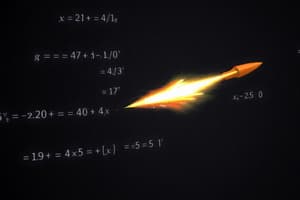Podcast
Questions and Answers
What is the primary purpose of vectors in motion analysis?
What is the primary purpose of vectors in motion analysis?
- To measure temperature changes
- To determine altitude levels
- To represent direction and magnitude (correct)
- To calculate the mass of objects
A scalar quantity has both magnitude and direction.
A scalar quantity has both magnitude and direction.
False (B)
What does the notation Δd represent in motion analysis?
What does the notation Δd represent in motion analysis?
displacement or change in position
Moving the decimal places to the left in scientific notation indicates a ______ exponent.
Moving the decimal places to the left in scientific notation indicates a ______ exponent.
Match the following terms related to motion with their definitions:
Match the following terms related to motion with their definitions:
What is the formula for average velocity?
What is the formula for average velocity?
Speed is a vector quantity.
Speed is a vector quantity.
What does Δ (Delta) signify in motion equations?
What does Δ (Delta) signify in motion equations?
The sum of all vector displacements is called the _________ vector.
The sum of all vector displacements is called the _________ vector.
Match the following terms with their definitions:
Match the following terms with their definitions:
Flashcards are hidden until you start studying
Study Notes
Significant Figures and Scientific Notation
- Significant digits indicate the accuracy of a measurement.
- Scientific notation expresses very large or small numbers in the form a x 10*^n^*.
- Large numbers: Moving the decimal left results in a positive exponent. Example: 4,500,000 = 4.5 x 10^6^.
- Small numbers: Moving the decimal right results in a negative exponent. Example: 0.00032 = 3.2 x 10^-4^.
- For addition and subtraction, round to the least precise value's decimal places. Example: 11.2 + 0.24 + 0.336 rounds to 11.8.
- For multiplication and division, the answer has the same number of significant digits as the least precise value. Example: (34.28)/(4.8) = 7.1 (rounded to 2 sig digs).
Kinematics Overview
- Kinematics is the science describing motion, focusing on the motion of objects excluding forces, masses, or energies.
Vectors and Scalars
- Scalar quantity: Only has magnitude (e.g., speed 80 km/h).
- Vector quantity: Has both magnitude and direction (e.g., velocity 120 km/h [North]).
- Vectors are essential for direction-dependent scenarios like navigation and flight planning.
Displacement and Equations
- Displacement (Δd) is the change in position, calculated as Δd = d_f - d_i.
- Directions can be represented with vector notation (e.g., d = 10m [E] - 5m [W] results in 15m [E]).
- Final position: d_f = d_i + Δd; Starting position: d_i = d_f - Δd.
Speed and Velocity
- Speed is a scalar; it does not account for direction.
- Velocity is a vector; it includes direction.
- Average velocity: V_av = Δd/Δt (displacement divided by time).
- Example: A car travels 220 km east in 2 hours; thus, V_av = 110 km/h [East].
Graphing Vectors
- Motion along a single axis involves collinear vectors.
- Vectors can be added graphically using the tip-to-tail method to find the resultant vector.
- Vector subtraction involves either direct computation or creating a new vector that points in the opposite direction.
Key Definitions
- Magnitude: Size of a quantity.
- Scalar: Quantity with magnitude only.
- Vector: Quantity with both magnitude and direction.
- Displacement: Change in position; vector quantity.
- Distance: Total ground covered; scalar quantity.
- Speed: Distance traveled per time unit.
- Velocity: Change of position with respect to time.
Position-Time Graphs
- Velocity is represented by the slope of a position-time graph (rise/run).
- A positive slope indicates movement forward; a negative slope indicates backward movement.
- Flat horizontal lines indicate rest; straight lines indicate constant velocity; curved lines show changing velocity.
Velocity-Time Graphs
- Velocity-time graphs plot velocity on the y-axis and time on the x-axis.
- Constant velocity is a flat line; positive velocity indicates forward movement, while negative velocity indicates backward movement.
Acceleration
- Defined as change in velocity per time (m/s^2).
- Uniform acceleration indicates a consistent change in velocity.
- The slope on a velocity-time graph represents acceleration.
Instantaneous Values
- Instantaneous velocity: slope of a tangent on a position-time graph; reflects the object's position at a specific moment.
- Instantaneous acceleration: slope of a tangent on a velocity-time graph; specific to a certain point.
Relationship Between Acceleration and Velocity
- If velocity and acceleration have the same sign, speed increases.
- If velocity and acceleration have opposite signs, speed decreases.
Studying That Suits You
Use AI to generate personalized quizzes and flashcards to suit your learning preferences.




